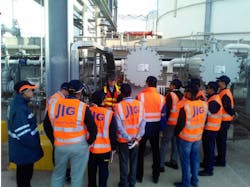JIG Publishes Filter Monitor Bulletin
JIG has published a bulletin for both members and the wider industry to highlight a response to recent studies and events surrounding the use of filter monitors in the aircraft fueling process.
Following the initial publication of a position statement by the IATA SAP Special Interest Group (SIG) on the future of filter monitors, JIG immediately initiated the work to prepare a Bulletin with actions and guidance of immediate and significant relevance to all users of Filter Monitor filtration systems in Aviation Fuel service. JIG has worked closely with both A4A and IATA to develop a globally consistent industry approach and a common implementation roadmap for the wider user community. Additionally, JIG has liaised with all filter manufacturers with qualified filtration products to explore options and timelines for the manufacture and supply of qualified filtration systems to the wider user community.
The key objective for JIG, in the short term, is to arrive at a roadmap with feasible implementation timelines that can lead to additional mitigation of the potential risks from Filter Monitor technology, offering a rapid but orderly exit from the Filter Monitor technology whilst reducing the potential for SAP migration in the interim, with no interruption in aircraft fuelling operations.
The JIG Bulletin issued on Monday 11th December and published in JIG’s website www.jigonline.com as an open document for Public use, has been unanimously agreed by the JIG Operations Committee and the JIG Council, and has been endorsed by both the IATA TFG and A4A.
The JIG bulletin includes as a further bulletin attachment, the final IATA SIG data report summary, which has been formally released. JIG is aware that there have been a lot of communications from manufacturers, suppliers and others in the industry, but users of the JIG Standards should follow the action plan included in this bulletin.
JIG will continue the work with all industry stakeholders to evaluate additional options in the medium term for other filtration/sensing technologies covered by EI specifications. JIG intends to encourage an accelerated industry development program to bring new and viable filtration technologies into service.
In the interim, JIG will implement a program to inform, assist and further support its membership. This program includes the following:
- additional JIG Bulletins, as necessary,
- focused JIG workshops and Members Technical Forums in 2018,
- guidance on the implementation of Bulletin actions by JIG inspectors during the 2018 JIG inspection program,
- web seminars for JIG members to have an opportunity to understand any issues and raise any questions. More information for the seminars will be communicated in due course.
Antonis Christodoulakis, JIG’s Technical Manager stated “In this significant time for the industry, JIG is committed to working intensively and responsibly to support the JIG member community in managing safe aircraft refueling operations around the world.”
